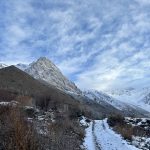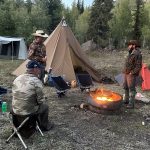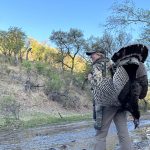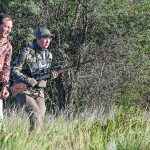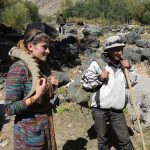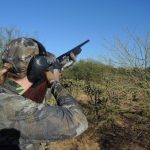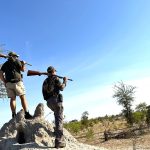In pursuit of the challenging chukar partridge on a cast-and-blast river trip.
The call echoed across the dry, rocky slope high above camp right after sunup. Chuk-chuk-chuk-chuk. Chuk-chuk-chuk-chuka-chuka.
Daren Cole, one of my hunting partners, heard it too. “It sounds like the chukar are laughing at us,” he said.
I was pretty sure he was right as I shrugged into my orange vest, located my shotgun, and studied the steep mountainside looming behind my tent. The vocal gamebirds had been testing our legs, lungs, and willpower for three days, and it looked like they had another graduate-level exam ready for us this morning.
Four of us headed up the mountain, following Ceder, the German wirehaired pointer, who bounded up the grassy slope and began casting back and forth between the rock outcrops and clumps of brush above us. We could still hear chukar calling from the ridgetop. Ceder worked his way higher and higher, and we followed, clambering over red boulders and ducking around thickets of brush. The dog disappeared over the top, and I increased my pace to double time. Hustling over the crest of the ridge, I spotted Ceder. His head was buried in a patch of brush on the edge of the precipice, his motionless rear end and straight tail clearly indicating he was on point.
As my hunting partner Nate Ratchford jumped up on a boulder to the dog’s right, I ran to cover the left. Two chukar flushed to the right with a heart-stopping rush, with just time for Nate to get off one quick shot before both birds put on their afterburners and screamed out of sight beneath a rock ledge. Ceder trotted after them, but by his unconcerned manner, I knew Nate had not connected. We were both panting from the hard sprint over the ridge and grinning from ear to ear.
We were still recovering from the effects of the exertion and the adrenaline rush when Daren and another member of our hunting party, Ashley Thess, caught up with us. We tried to continue our way across the mountain slope into the wind, following Ceder, but the sheer face became steeper and steeper and we soon found ourselves cliffed out. Turning back, we returned to the ridgetop, where we stopped to admire the view of our riverside camp, a collection of white tents and bright blue rafts so far below us they looked like miniatures. I could just see the ant-like figures of our river guides as they worked to strike the tents and pack up the rafts in preparation for the day’s float.
It was the last morning of a four-day cast-and-blast float trip through the magnificent Hells Canyon. Cutting a jagged slice along the border of Oregon and Idaho, Hells Canyon is the deepest river gorge in North America—even deeper than the far more famous Grand Canyon. Far below where we stood with our shotguns, and well over a mile below the very top of the canyon rim, wound the mighty Snake River, our highway through chukar country. The canyon itself, part of the Wallowa-Whitman National Forest, contains some 214,000 acres of wilderness, almost all of it inaccessible by road.

The difficulty in access, combined with excellent habitat, makes Hells Canyon a top destination for hunting the challenging and elusive chukar partridge. The Snake River is also a world-class fishery. Smallmouth bass and rainbow trout can be caught all year, with hundred-fish days a distinct possibility, and the river also hosts runs of steelhead and chinook salmon in the spring and fall.
All of this makes it a perfect destination for a cast-and-blast river trip. Our float, outfitted by America’s Rafting Company based in Cambridge, Idaho, took us about thirty-four miles from the launch point just below Hells Canyon Dam to our take-out point at Pittsburg Landing, Idaho. Along the way, we ran some Class IV rapids, camped along the river every night, and fished for the river’s many species–all the while being treated to magnificent scenery and sightings of black bears, bighorn sheep, and bald eagles. Best of all, though, the guides would periodically beach the rafts at likely-looking spots, setting us free to hike up the steep walls of the canyon, shotguns in hand and dogs casting eagerly ahead, in search of chukar.
Chukar partridge were introduced to the American West from their native range in southern and central Asia, and the high desert slopes of Idaho, Nevada, and eastern Oregon suit these birds to a T. The chukar is an attractive bird, with dark stripes on its side and a banded head and neck with a red bill, but its most striking feature is its ability to run, covering incredibly steep terrain with agility, staying ahead of even the most athletic pointing dogs and earning it the nickname “devil bird” from the often-frustrated hunters who try to chase it.
Because chukar live in such parched terrain, water is key to hunting them. Although it had been an inordinately dry summer in most of the West, we had been unlucky enough to start our float just after a significant rainfall had drenched the Hells Canyon region. The coveys, which would normally be concentrated along the river’s edge this time of year, had no need to fly down to the water, since the numerous rocks and ridgelines high up on the canyon walls still held pools of moisture. And since the birds weren’t coming down . . . well, that meant the hunters would have to go up.
Nate, Daren, Ashley, and I were all first-time chukar hunters, but we had a secret weapon along: chukar-hunting guru Matt Hardinge, who joined us on the trip with his two talented and tireless German wirehaired pointers, Ceder and Summit. On one of our first hunts with Matt, we watched in awe as he and the dogs effortlessly scaled an almost-vertical, brush-choked slope and topped the ridge in minutes. Stumbling and panting in his wake, I was nowhere near close enough when a covey of chukar flushed, seeming to fly in all directions. After a missed shot, Matt and the dogs pursued a couple of the singles, but the birds had quickly learned their lesson and stuck to running, outdistancing even their ultra-athletic pursuers. I was not surprised to learn later that Matt’s other hobbies include rock climbing and mountaineering, which would seem to mesh perfectly with chukar hunting.
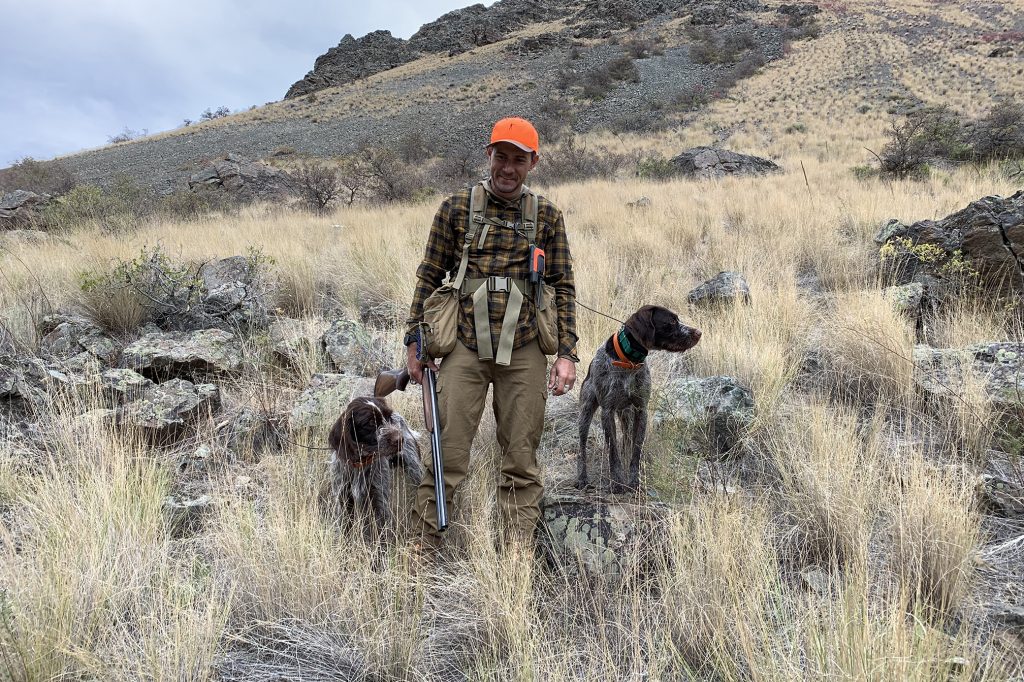
Despite the overcast, chilly October weather, every day of our float trip was a magnificent blend of relaxation and adventure. Each morning started with a hot, hearty breakfast, followed by some hunting time while the guides broke down camp. Then we’d drift downriver for a couple of hours, our guides expertly steering the rafts through long, slow pools and occasional splashy rapids that bounced the rafts, elicited lots of shouts and laughter, and soaked any parts of our anatomy not covered in rain gear. All the while we were casting spinners for rainbow trout and tube jigs for feisty and abundant smallmouth bass; one memorable morning I landed ten big rainbows.
After a shore lunch we’d usually try again for chukar, scrambling up the canyon walls on either the Idaho or Oregon side. Once we stopped to marvel at pictographs painted on the rocks—artwork estimated to be 2,000 years old—and several times we passed the remnants of frontier homesteads, the fruit trees they had planted the only thing remaining of their long-ago dreams.
Afternoons would bring more floating and more fishing, with a well-appointed shoreside camp and a hearty dinner awaiting us at dusk. Once we trolled crankbaits through an eddy to entice steelhead and salmon, and long after dark one evening, we all piled on the rafts and aimed our headlamps into the water as a prehistoric-looking six-foot-long sturgeon was caught and gently released into the dark depths of the Snake.
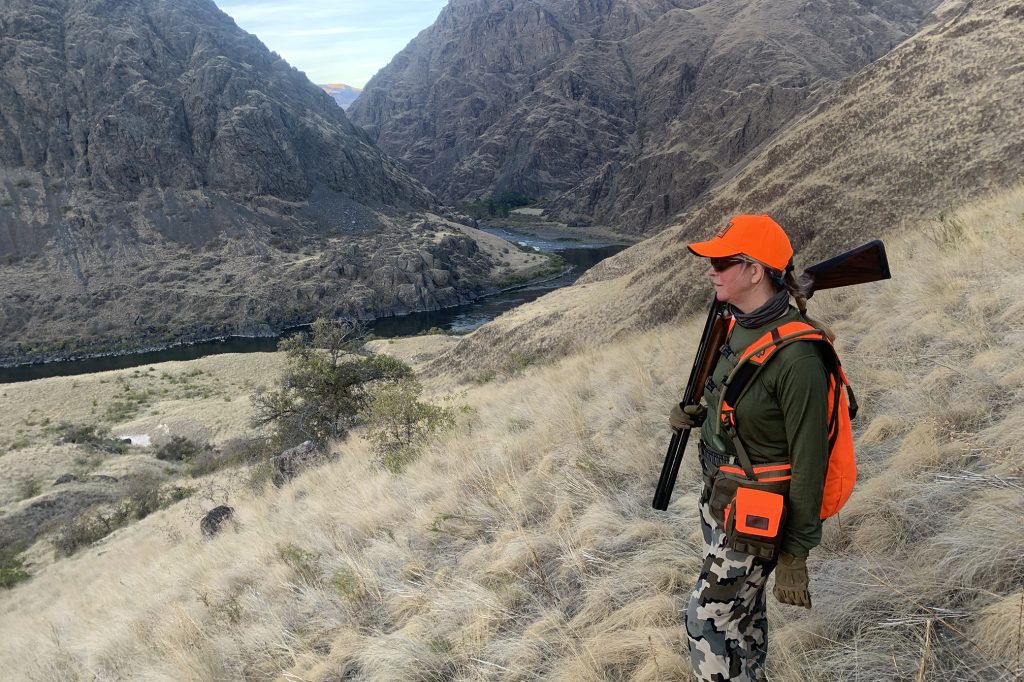
On the third afternoon, high above the river with shotguns in hand, Nate, Daren, Ashley and I were keeping pace with Matt, Ceder, and Summit across a rocky sidehill, which meant the slope must have been less steep or else we were all finally finding our chukar legs. It was ideal habitat for the birds, and as we passed towering red rock outcroppings, Matt pointed out their ice-cream-cone shaped droppings and a couple of abandoned nests.
After some time watching the pointers work the slope ahead, Matt made the call to turn around. As we headed back through a jumble of boulders, Nate, who was slightly ahead, spotted a chukar that leaped to the top of a rock ahead of him. As it flushed, another bird erupted from somewhere and flew over our heads. All the shots at both birds were misses, and although we worked back and forth through the area with the dogs for another twenty minutes, we could not put the birds up again.
“Surprising to find only a couple of birds together,” Matt remarked, speculating that another group of hunters might have worked the slope the day before and scattered the covey.
Fortunately for our palates, he had dropped three chukar the day before, and we enjoyed “chukar bites” that evening: delicious nuggets of chukar meat lightly breaded and fried. They were served alongside a filet of fresh-caught Chinook salmon: a true Hells Canyon surf-and-turf.

Before we shoved off on the last day, our guides rowed us across the river from Oregon to Idaho to give the elusive birds one last try. Ashley and I worked across the slope parallel to the river, flushing a covey of chukar far out ahead of us, where they landed and, naturally, ran uphill. Matt and Nate pursued them to the top of the ridgeline. When a group of birds flushed, Matt got a shot and dropped one, Ceder finding it easily in the rocks and returning it to him with aplomb. That made a total of four birds in the bag over our four-day hunt—all of them Matt’s, and deservedly so.
As we made the final float down to our take-out point, the canyon widened, opening up new, magnificent vistas around every sweeping bend of the river. I had traded my shotgun for a spinning rod, but between casts I studied the mountainsides, reflecting on my newfound respect for the fascinating “devil bird,” and especially for the mountain-savvy hunters and dogs who pursue them. It was a rare privilege to experience a true fair-chase hunt for wild chukar in one of the most spectacular river gorges in the world.

Benelli 828U
All five of us on my Hells Canyon adventure were carrying 12-gauge Benelli 828U shotguns. Of course, I spent a lot more time hiking with my shotgun than I did actually firing it, an experience that, I’m told, is not unusual in chukar hunting. But I like the 828U so much I previously bought one in 20-gauge and have used it extensively over the past year for shooting clays as well as hunting doves and pheasants. It’s soft-shooting, fits me well, and carries and points like a dream.
A lightweight, well-balanced, and ultra-reliable shotgun is an absolute must when you’re hunting mountain birds in a wilderness setting, and the 828U fulfills those requirements to perfection. It features a patented steel locking system, which eliminates wear and tear on the receiver and hinge that can cause traditional over/unders to fail. By incorporating this system into an aluminum receiver, Benelli’s engineers created a shotgun that is stronger and safer, while still balancing beautifully and weighing just 6.5 pounds.
Fit is crucial in any shotgun, and the 828U includes shims so you can adjust stock drop and cast to your specifications. This shotgun also features Benelli’s Progressive Comfort System inside its walnut stock. The flexible and lightweight polymer buffers compress to absorb recoil energy, making this over/under comfortable to shoot repeatedly, whether you’re gunning for a limit of birds or practicing with a round of sporting clays.
For more information on Hells Canyon float trips and cast-and-blast trips, click here.


